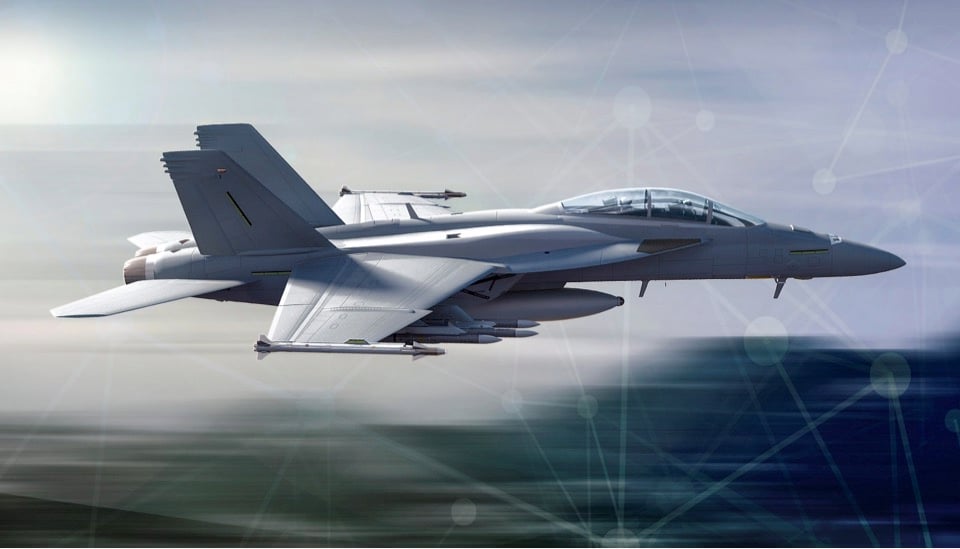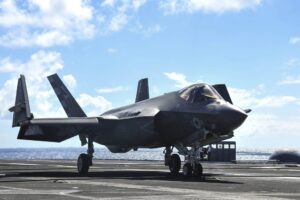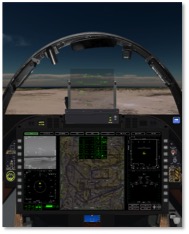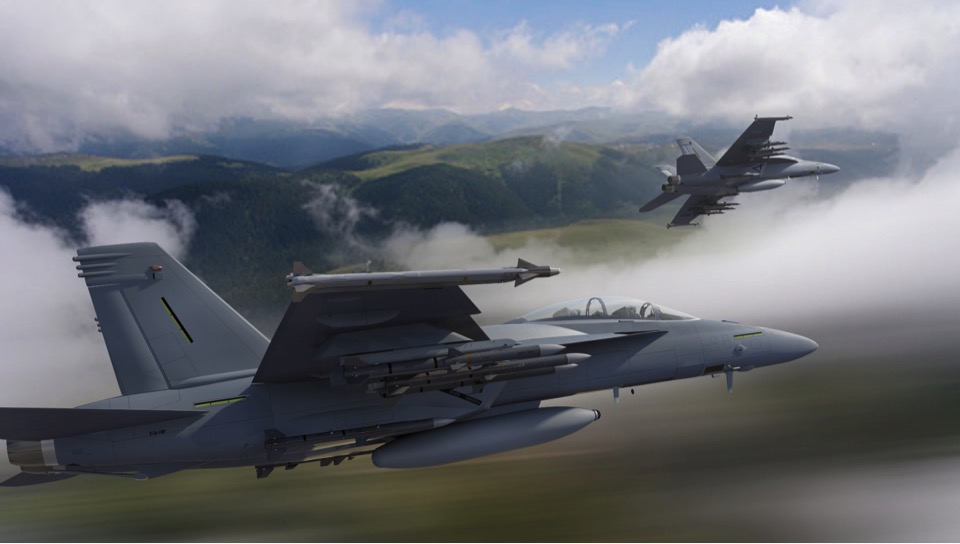Navy, Boeing Tout Block III Super Hornet As Partner For F-35
Posted on

F/A-18 Super Hornet Block III
ARLINGTON: The Navy is upgrading its Super Hornet fighters with new sensors and networks so they can collaborate in combat with the F-35. Over the 2019-2024 budget plan, the service plans to pay Boeing to build 116 new Block III Super Hornets and convert many of its nearly 500 existing Super Hornets to Block II standard.
Once touted by President Trump himself as an alternative to the F-35, the souped-up Super Hornet is now firmly established as its partner. Here’s how that partnership might work in wartime, as depicted by Navy and Boeing officials in briefings for the press this morning.

F-35C
First, stealthy F-35Cs scout ahead into hostile airspace and spot enemy stealth fighters in flight. They report over the Link-16 network back to an E-2D Hawkeye command plane circling far in the rear, out of range of enemy anti-aircraft fire, and under the protection of EA-18G Growler radar-jamming planes. The E-2D transmits the data over the higher-bandwidth TTNT network to F/A-18 Super Hornets, red icons popping up on the Block III’s improved cockpit displays.
While the hostiles are hard to pinpoint on radar, many Block III Hornets have advanced Infra-Red Search & Track sensors that can pick up their engine heat. Two ISRT-equipped Hornets intercept from different angles to triangulate their targets precisely, sharing data over TTNT, then open fire.
With every hardpoint under their wings available for weapons — the Hornets carry extra fuel in conformal tanks along the fuselage instead of traditional drop tanks, and they don’t need to worry about stealth — the Hornets can unleash a deadly barrage, firing eight air-to-air missiles each. The enemy air raid is annihilated.
Based on the tremendous cost and cost overruns of the Lockheed Martin F-35, I have asked Boeing to price-out a comparable F-18 Super Hornet!
— Donald J. Trump (@realDonaldTrump) December 22, 2016
From Competitor to Complement
The partnership between the two planes is a far cry from President Trump’s tweet suggesting the Pentagon replace the F-35 with “a comparable F-18 Super Hornet!” or Boeing’s own past pitch to substitute Super Hornets for F-35s. Many Navy leaders had been ambivalent about the F-35, but last year the service resolved that the two planes were “complementary.”

Advanced Cockpit System (ACS) for Block III Super Hornet
It’s not just a change in tone: The Super Hornet variants on offer are physically different. When Boeing saw itself in direction competition with the stealthy F-35, it flight-tested an experimental Advanced Super Hornet advertised as 50 percent stealthier than the Navy’s current model. What the Navy’s actually buying from Boeing, however, is the Super Hornet Block III, whose radar cross section is only 10 percent less.
“The Navy’s Carrier Air Wing doesn’t need us to be at F-35 levels of stealth; they have that in the F-35,” Boeing program manager Dan Gillian told reporters. “They’ve asked us to improve our radar cross section a little bit — which is what we’re doing here — and they need us to carry large amounts of ordnance far forward.”
Instead of stealth, Boeing is now touting other features of the Super Hornet. That includes the large number of weapons it carries under the wings, which incidentally make it much less stealthy. Stealth requires smooth, unbroken curves, which is why the F-35 has internal weapons bays, but internal capacity is less than under-wing. That’s why the Navy sees a symbiotic relationship where the stealthy F-35 scouts ahead and finds targets for the less stealthy but more heavily armed Super Hornets.

Block III Super Hornets showing the heavy load of munitions under the wings.
Features & Timeline
To make this symbiosis work, the Super Hornet needs new electronics, which are one of the most prominent features of the Block III model. Upgrading to Block III adds
- the Lockheed Martin MUOS (Mobile User Objective System) satellite communications link to share data with friendly forces too far away for line-of-sight radio.
- the Rockwell Collins TTNT (Tactical Targeting Network Technology) network also found on the EA-18G Growler (itself a Super Hornet variant) and E-2G Hawkeye, allowing rapid transfer of large amounts of data even in the face of hostile jamming. TTNT is in turn part of the NIFC-CA (Naval Integrated Fire Control – Counter-Air) system.
- the Distributed Targeting Processor-Networked (DTP-N), which handles all that data onboard the aircraft, boasting 17 times the processor speed of current (Block II) Super Hornets and an open architecture for easier upgrades in the future.
- the Infrared Search and Track (IRST) sensor, which is bought under a separate program; not every Block III Super Hornet will have the sensor (or need it, since it’s mainly relevant to air-to-air combat, not anti-ship or ground attack missions). A single aircraft with ISRT can only determine what direction the enemy is in, but two aircraft sharing data over TTNT can triangulate the precise location, giving targeting-quality data.
- the Advanced Cockpit System (ACS) to pull together all the data from these different sensors and networks into a clear and intuitive picture.
- conformal fuel tanks which fit snugly against the aircraft’s hull, streamlined so they don’t create aerodynamic drag or glaring radar reflections like traditional drop tanks. As a result, the Block III will be able to strike targets about 120 nautical miles further away than the Block II or stay on station longer over friendly forces it’s protecting.
- a 10 percent reduction in radar cross section, although this will be more than cancelled out by carrying missiles under the wing.
- a 50 percent increase in service life, from 6,000 to 9,000 flight hours. To last this much longer, new-construction Block IIIs will have redesigned and stronger components, while existing Block IIs being upgraded to IIIs will have their structure reinforced in key places.
What’s the timeline to deliver all this?
- 2019: Boeing will deliver two test jets to the Navy.
- Late 2020: Serial production of new Block IIIs will begin in late 2020 at Boeing’s Saint Louis plant.
- 2021: Conformal fuel tanks for the planes will finish testing and enter service.
- 2022: Boeing will begin converting existing Block IIs to Block IIIs, both in Saint Louis and at a new facility in San Antonio. The first operational squadron of Block IIIs will deploy.
Or things could move faster, the Navy’s program manager said. “I’m under a lot of pressure to pull everything left,” Capt. David Kindley told reporters, “so I would imagine that you’re going to see this technology coming out maybe even a few years earlier.”
On the current schedule, the Navy will have one full squadron of Block III Super Hornets in each carrier air wing by 2024 and two squadrons by 2027. The other two squadrons on each carrier in this plan? F-35Cs.
Subscribe to our newsletter
Promotions, new products and sales. Directly to your inbox.
